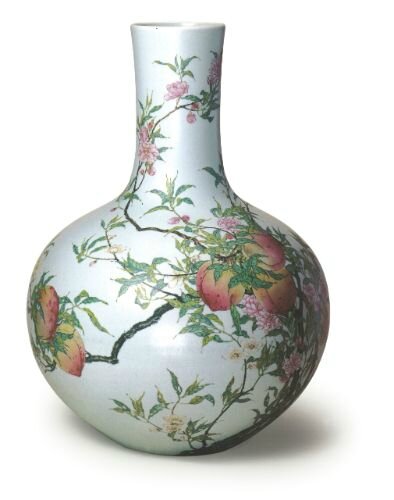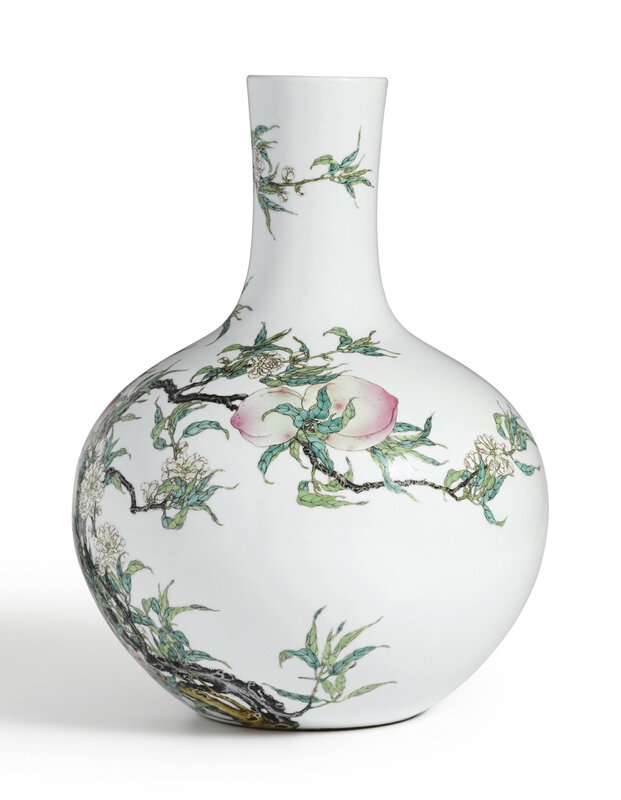A Magnificent Famille-Rose 'Peach' Vase, Tianqiuping, Seal Mark and Period of Qianlong (1736-1795)
Lot 15. A Magnificent Famille-Rose 'Peach' Vase, Tianqiuping, Seal Mark and Period of Qianlong (1736-1795); 51 cm., 20 in. Estimate 80,000,000-120,000,000 HKD. Lot sold 90,260,000 HKD (11,596,605 USD). Photo Sotheby's
the bottle-shaped vase with a globular body rising to a cylindrical neck flaring slightly at the rim, masterfully painted with an asymetric design of two peach branches growing halfway around the vase and wrapping around the neck, one gnarled branch depicted with brown bark and pink blossoms, the other with dark grey bark with white blossoms edged in pink, the nine peaches depicted in different stages of ripeness ranging in colour from light yellowish green to rose-pink deepening to darker pink spots and patches, the green enamelled leaves shaded in turquoise and a yellowish green to distinguish their top and underside, the lichen on the bark picked out in white and light turquoise-blue dots, the recessed base inscribed with a six-character reign mark
Provenance: Christies Hong Kong, 30th October 1995, lot 760.
Exhibited: Evolution to Perfection. Chinese Ceramics from the Meiyintang Collection/Evolution vers la perfection. Céramiques de Chine de la Collection Meiyintang, Sporting d’Hiver, Monte Carlo, 1996, cat. no. 185 (illustrated).
Literature: Regina Krahl, Chinese Ceramics from the Meiyintang Collection, London, 1994-2010, vol. 4, no. 1756.
Nine Peaches for the Qianlong Emperor. Regina Krahl
It was only in the Yongzheng period that the porcelain painters could begin painting nature scenes in their natural — if idealized — colours. Once the Jingdezhen craftsmen, inspired by foreign rnateriais that had been brought to the court in Beijing, were able to produce new enamel colours themselves, the palette of tones available for painting porcelains was vastly increased. This sparked off the development of a number of exquisite painteriy designs of fruiting and flowering trees, as seen on this ‘peach’ tianqiuping, as weil as the ‘peach’ bow, lot 16, and the dish with prunus, bamboo and roses, lot 22. The superb pattern cf twin flowering and fruiting peach trees extending around the sides of this massive vasebecame one cf the best-loved porcelain designs in the Qianlong period. The colour combination has an irresistible appeal, the painting is magnificent, and the design of two trees with different blossoms and bark, whose interlaced branches together bear nine fruit, is sophisticated in its concept and reassuring in its eternal message conveying affluence and long life.
Although this design seems to be ultimately based on a Kangxi pattern developed in the imperial enamelling workshops cf the Forbidden City, Beijing, its obvious auspicious relevance would have made it popular with the Yongzheng as well as the Qianlong Emperor, who had peaches represented in ail possible media. The peach design was particularly well suited, however, te the newly developed fencai palette with its pastel shades of pink, yellow and green.
Multiple popular stories have developed over the centuries linking peaches to endless bliss. Tao Qian (365-427) tells cf a fisherman, who through a crevice in a rock followed the course of a stream to a peach orchard, Peach Blossom Spring’, where he discovered a paradisiacal world. In the novel Romance of the Three Kingdoms the three main protagonists are swearing an oath of brotherhood in a peach orchard. Peaches bestowing immortality are said to grow in the garden of Xi Wang Mu, the Queen Mother of the West, taking three thousand years to flower and the same time again to bear fruit. Due to their magical powers these peaches are said to have been repeatedly stolen, flrst by the clever Han dynasty scholar Dongfang Shuo (2nd/lst century BC) who thus turned immortal, and Pater by the scheming monkey Sun Wukcng, hero of the novel Journey to the West, who in the 7th century is supposed to have accompanied the monk Xuanzang on his trip to India in search of Buddhist scriptures.
Tian qiuping of this design are in the Palace Museum, Beijing, see Kangxi, Yongzheng, Qianlong. Qing Porcelain from the Palace Museum Collection, Hong Kong, 1989, p. 335, pI. 16; and Geng Baochang, Ming Qing ciqijianding [Appraisal of Ming and Qing porcelain], Hong Kong, 1993, fig. 443; in the National Palace Museum, Taiwan, see Gugong Qing ci tulu. Qianlong yao, Jiaqingyao, Daoguang yao ta/lllustrated Catalogue of Ch’ing Dynasty Porcelain in the National Palace Museum, Republic of China: Ch’ien-lung Ware and Other Wares, Tokyo, 1981, pl.27; in the National Museum of China, Beijing, see Zhongguo Guojia Bowuguan guancang wenwu yanjiu congshu/Studies on the Collections ofthe National Museum of China. Ciqi juan [Porcelain section]: Qingdai [Qing dynasty], Shanghai, 2007, pI. 88; in the Metropolitan Museum of Art, New York, see Suzanne G. Valenstein, A Handbook of Chinese Ceramics, New York, 1989, col. pI. 42; in the British Museum, London, published in Jessica Rawson, ed., The British Museum Book of Chinese Art, London, 1992, pI. 187; and the Asian Art Museum of San Francisco, illustrated in Li He, Chinese Ceramics. The New Standard Guide, London, 1996, no. 663.
For one of the rare Yongzheng prototypes, with only eight peaches, see a piece in the Palace Museum, Beijing, in Geng Baochang, ed., Gugong Bowuyuan cang Qingdaiyuyao ciqi [Porcelains from the Qing dynasty irriperial kilns in the Palace Museum collection], Beijing, 2005, vol. 1, part 2, pI. 76 (fig. 1); another from the Barbara Hutton collection, painted with nine peaches, included in the exhibition The Barbara Hutton Collection of Chinese Porcelain, Honolulu Academy of Arts, Honolulu, 1956-7, catalogue pI. XV, was sold in our London rooms, 6th July 1971, lot 259, and later in these rooms, 3àth April 1996, lot 498. The inspiration for this design may have corne from a falangcai copper vase in the Palace Museum, Beijing (fig. 1) or a similar piece.

Fencai eight peach tianqiuping, Mark and period of Yongzheng, Palace Museum, Beijing

Falangcai ‘peach-and-bat’ copper vase, Mark and period of Kangxi, Palace Museum, Beijing
Sotheby's. The Meiyintang Collection, Part II - An Important Selection of Chinese Porcelains. Hong Kong, 5 october 2011

/https%3A%2F%2Fprofilepics.canalblog.com%2Fprofilepics%2F1%2F0%2F100183.jpg)
/https%3A%2F%2Fstorage.canalblog.com%2F03%2F02%2F119589%2F96711876_o.jpg)
/https%3A%2F%2Fstorage.canalblog.com%2F11%2F31%2F119589%2F94773502_o.jpg)
/https%3A%2F%2Fstorage.canalblog.com%2F20%2F83%2F119589%2F94772815_o.jpg)
/https%3A%2F%2Fstorage.canalblog.com%2F26%2F72%2F119589%2F75604929_o.jpg)
/https%3A%2F%2Fstorage.canalblog.com%2F59%2F60%2F119589%2F26458628_o.jpg)





/http%3A%2F%2Fstorage.canalblog.com%2F59%2F39%2F119589%2F129631842_o.jpg)
/http%3A%2F%2Fstorage.canalblog.com%2F77%2F79%2F119589%2F129631259_o.jpg)
/http%3A%2F%2Fstorage.canalblog.com%2F64%2F85%2F119589%2F129631160_o.jpg)
/http%3A%2F%2Fstorage.canalblog.com%2F09%2F41%2F119589%2F129627152_o.jpg)